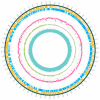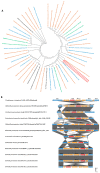Emergence and Transfer of Plasmid-Harbored rmtB in a Clinical Multidrug-Resistant Pseudomonas aeruginosa Strain
- PMID: 36144421
- PMCID: PMC9500886
- DOI: 10.3390/microorganisms10091818
Emergence and Transfer of Plasmid-Harbored rmtB in a Clinical Multidrug-Resistant Pseudomonas aeruginosa Strain
Abstract
Multidrug-resistant (MDR) Pseudomonas aeruginosa poses a great challenge to clinical treatment. In this study, we characterized a ST768 MDR P. aeruginosa strain, Pa150, that was isolated from a diabetic foot patient. The minimum inhibitory concentration (MIC) assay showed that Pa150 was resistant to almost all kinds of antibiotics, especially aminoglycosides. Whole genome sequencing revealed multiple antibiotic resistant genes on the chromosome and a 437-Kb plasmid (named pTJPa150) that harbors conjugation-related genes. A conjugation assay verified its self-transmissibility. On the pTJPa150 plasmid, we identified a 16S rRNA methylase gene, rmtB, that is flanked by mobile genetic elements (MGEs). The transfer of the pTJPa150 plasmid or the cloning of the rmtB gene into the reference strain, PAO1, significantly increased the bacterial resistance to aminoglycoside antibiotics. To the best of our knowledge, this is the first report of an rmtB-carrying conjugative plasmid isolated from P. aeruginosa, revealing a novel possible transmission mechanism of the rmtB gene.
Keywords: Pseudomonas aeruginosa; conjugative plasmid; mobile genetic element; multidrug-resistance; rmtB.
Conflict of interest statement
The authors declare no conflict of interest.
Figures




Similar articles
-
Characterization and Implications of IncP-2A Plasmid pMAS152 Harboring Multidrug Resistance Genes in Extensively Drug-Resistant Pseudomonas aeruginosa.Microorganisms. 2024 Mar 12;12(3):562. doi: 10.3390/microorganisms12030562. Microorganisms. 2024. PMID: 38543613 Free PMC article.
-
Co-Occurrence of Rare ArmA-, RmtB-, and KPC-2-Encoding Multidrug-Resistant Plasmids and Hypervirulence iuc Operon in ST11-KL47 Klebsiella pneumoniae.Microbiol Spectr. 2022 Apr 27;10(2):e0237121. doi: 10.1128/spectrum.02371-21. Epub 2022 Mar 24. Microbiol Spectr. 2022. PMID: 35323034 Free PMC article.
-
High prevalence of plasmid-mediated 16S rRNA methylase gene rmtB among Escherichia coli clinical isolates from a Chinese teaching hospital.BMC Infect Dis. 2010 Jun 23;10:184. doi: 10.1186/1471-2334-10-184. BMC Infect Dis. 2010. PMID: 20573216 Free PMC article.
-
Characterization of an rmtB-carrying IncI1 ST136 plasmid in avian Escherichia coli isolates from chickens.J Med Microbiol. 2016 May;65(5):387-391. doi: 10.1099/jmm.0.000240. Epub 2016 Mar 1. J Med Microbiol. 2016. PMID: 26932741
-
Distribution of conjugative-plasmid-mediated 16S rRNA methylase genes among amikacin-resistant Enterobacteriaceae isolates collected in 1995 to 1998 and 2001 to 2006 at a university hospital in South Korea and identification of conjugative plasmids mediating dissemination of 16S rRNA methylase.J Clin Microbiol. 2008 Feb;46(2):700-6. doi: 10.1128/JCM.01677-07. Epub 2007 Dec 19. J Clin Microbiol. 2008. PMID: 18094126 Free PMC article.
Cited by
-
Phenotypic and genomic characterization of Pseudomonas aeruginosa isolates recovered from catheter-associated urinary tract infections in an Egyptian hospital.Microb Genom. 2023 Oct;9(10):001125. doi: 10.1099/mgen.0.001125. Microb Genom. 2023. PMID: 37902186 Free PMC article.
-
A single-center retrospective study of the molecular epidemiological characteristics of different Klebsiella pneumoniae infections in northern China.J Thorac Dis. 2024 Nov 30;16(11):7739-7750. doi: 10.21037/jtd-24-1148. Epub 2024 Nov 29. J Thorac Dis. 2024. PMID: 39678907 Free PMC article.
-
Characterization and Implications of IncP-2A Plasmid pMAS152 Harboring Multidrug Resistance Genes in Extensively Drug-Resistant Pseudomonas aeruginosa.Microorganisms. 2024 Mar 12;12(3):562. doi: 10.3390/microorganisms12030562. Microorganisms. 2024. PMID: 38543613 Free PMC article.
References
-
- García-Ulloa M., 2nd, Ponce-Soto G.Y., González-Valdez A., González-Pedrajo B., Díaz-Guerrero M., Souza V., Soberón-Chávez G. Two Pseudomonas aeruginosa clonal groups belonging to the PA14 clade are indigenous to the Churince system in Cuatro Ciénegas Coahuila, México. Environ. Microbiol. 2019;218:2964–2976. doi: 10.1111/1462-2920.14692. - DOI - PubMed
Grants and funding
LinkOut - more resources
Full Text Sources

